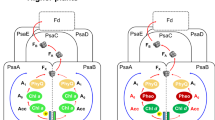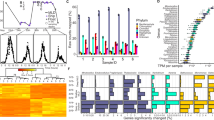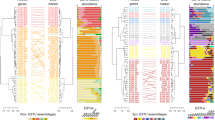Abstract
Chlorophyll d is a photosynthetic pigment that, based on chemical analyses, has only recently been recognized to be widespread in oceanic and lacustrine environments. However, the diversity of organisms harbouring this pigment is not known. Until now, the unicellular cyanobacterium Acaryochloris marina is the only characterized organism that uses chlorophyll d as a major photopigment. In this study we describe a new cyanobacterium possessing a high amount of chlorophyll d, which was isolated from waters around Heron Island, Great Barrier Reef (23° 26′ 31.2″ S, 151° 54′ 50.4″ E). The 16S ribosomal RNA is 2% divergent from the two previously described isolates of A. marina, which were isolated from waters around the Palau islands (Pacific Ocean) and the Salton Sea lake (California), suggesting that it belongs to a different clade within the genus Acaryochloris. An overview sequence analysis of its genome based on Illumina technology yielded 871 contigs with an accumulated length of 8 371 965 nt. Their analysis revealed typical features associated with Acaryochloris, such as an extended gene family for chlorophyll-binding proteins. However, compared with A. marina MBIC11017, distinct genetic, morphological and physiological differences were observed. Light saturation is reached at lower light intensities, Chl d/a ratios are less variable with light intensity and the phycobiliprotein phycocyanin is lacking, suggesting that cyanobacteria of the genus Acaryochloris occur in distinct ecotypes. These data characterize Acaryochloris as a niche-adapted cyanobacterium and show that more rigorous attempts are worthwhile to isolate, cultivate and analyse chlorophyll d-containing cyanobacteria for understanding the ecophysiology of these organisms.
Similar content being viewed by others
Log in or create a free account to read this content
Gain free access to this article, as well as selected content from this journal and more on nature.com
or
References
Akimoto S, Murakami A, Yokono M, Koyama K, Tsuchiya T, Miyashita H et al. (2006). Fluorescence properties of the chlorophyll d-dominated cyanobacterium Acaryochloris sp. strain Awaji. J Photochem Photobiol A Chem 178: 122–129.
Aziz RK, Bartels D, Best AA, DeJongh M, Disz T, Edwards RA et al. (2008). The RAST server: rapid annotations using subsystems technology. BMC Genomics 9: 75.
Chan YW, Nenninger A, Clokie SJ, Mann NH, Scanlan DJ, Whitworth AL et al. (2007). Pigment composition and adaptation in free-living and symbiotic strains of Acaryochloris marina. FEMS Microbiol Ecol 61: 65–73.
Chen M, Floetenmeyer M, Bibby TS . (2009). Supramolecular organization of phycobiliproteins in the chlorophyll d-containing cyanobacterium Acaryochloris marina. FEBS Lett 583: 2535–2539.
Chen M, Hiller RG, Howe CJ, Larkum AW . (2005). Unique origin and lateral transfer of prokaryotic chlorophyll-b and chlorophyll-d light-harvesting systems. Mol Biol Evol 22: 21–28.
Chen M, Quinnell RG, Larkum AW . (2002). The major light-harvesting pigment protein of Acaryochloris marina. FEBS Lett 514: 149–152.
Chen M, Zhang Y, Blankenship RE . (2008). Nomenclature for membrane-bound light-harvesting complexes of cyanobacteria. Photosynth Res 95: 147–154.
Cho JC, Giovannoni SJ . (2003). Parvularcula bermudensis gen. nov., sp. nov., a marine bacterium that forms a deep branch in the α-Proteobacteria. Internat J Syst Evol Microbiol 53: 1031–1036.
de los Rios A, Grube M, Sancho LG, Ascaso C . (2007). Ultrastructural and genetic characteristics of endolithic cyanobacterial biofilms colonizing Antarctic granite rocks. FEMS Microbiol Ecol 59: 386–395.
Dufresne A, Ostrowski M, Scanlan DJ, Garczarek L, Mazard S, Palenik BP et al. (2008). Unraveling the genomic mosaic of a ubiquitous genus of marine cyanobacteria. Genome Biol 9: R90.
Duxbury Z, Schliep M, Ritchie RJ, Larkum AW, Chen M . (2009). Chromatic photoacclimation extends utilisable photosynthetically active radiation in the chlorophyll d-containing cyanobacterium, Acaryochloris marina. Photosynth Res 101: 69–75.
Fiedler G, Arnold M, Hannus S, Maldener I . (1998). The DevBCA exporter is essential for envelope formation in heterocysts of the cyanobacterium Anabaena sp. strain PCC 7120. Mol Microbiol 27: 1193–1202.
Finsinger K, Scholz I, Serrano A, Morales S, Uribe-Lorio L, Mora M et al. (2008). Characterization of true-branching cyanobacteria from geothermal sites and hot springs of Costa Rica. Environ Microbiol 10: 460–473.
Gloag RS, Ritchie RJ, Chen M, Larkum AW, Quinnell RG . (2007). Chromatic photoacclimation, photosynthetic electron transport and oxygen evolution in the chlorophyll d-containing oxyphotobacterium Acaryochloris marina. Biochim Biophys Acta 1767: 127–135.
Goh F, Allen MA, Leuko S, Kawaguchi T, Decho AW, Burns BP et al. (2009). Determining the specific microbial populations and their spatial distribution within the stromatolite ecosystem of Shark Bay. ISME J 3: 383–396.
Hu Q, Marquardt J, Iwasaki I, Miyashita H, Kurano N, Morschel E et al. (1999). Molecular structure, localization and function of biliproteins in the chlorophyll a/d containing oxygenic photosynthetic prokaryote Acaryochloris marina. Biochim Biophys Acta 1412: 250–261.
Huelsenbeck JP, Ronquist F . (2001). MRBAYES: Bayesian inference of phylogenetic trees. Bioinformatics 17: 754–755.
Jeffrey SW, Vesk M . (1997). Introduction to marine phytoplankton and their pigment signatures. In: Jeffrey SW, Mantoura RFC, Wright SW (eds). Phytoplankton Pigments in Oceanography. UNESCO: Paris. pp 37–84.
Kashiyama Y, Miyashita H, Ohkubo S, Ogawa NO, Chikaraishi Y, Takano Y et al. (2008). Evidence of global chlorophyll d. Science 321: 658.
Kettler GC, Martiny AC, Huang K, Zucker J, Coleman ML, Rodrigue S et al. (2007). Patterns and implications of gene gain and loss in the evolution of Prochlorococcus. PLoS Genet 3: e231.
Kühl M, Chen M, Ralph PJ, Schreiber U, Larkum AW . (2005). Ecology: a niche for cyanobacteria containing chlorophyll d. Nature 433: 820.
LaRoche J, van der Staay GW, Partensky F, Ducret A, Aebersold R, Li R et al. (1996). Independent evolution of the prochlorophyte and green plant chlorophyll a/b light-harvesting proteins. Proc Nat Acad Sci USA 93: 15244–15248.
Lokstein H, Steglich C, Hess WR . (1999). Light-harvesting antenna function of phycoerythrin in Prochlorococcus marinus. Biochim Biophys Acta 1410: 97–98.
Manning WM, Strain HH . (1943). Chlorophyll d: a green pigment in red algae. J Biol Chem 151: 1–19.
Marquardt J, Senger H, Miyashita H, Miyachi S, Morschel E . (1997). Isolation and characterization of biliprotein aggregates from Acaryochloris marina, a Prochloron-like prokaryote containing mainly chlorophyll d. FEBS Lett 410: 428–432.
McNamara CJ, Perry IV TD, Bearce KA, Hernandez-Duque G, Mitchell R . (2006). Epilithic and endolithic bacterial communities in limestone from a Maya archaeological site. Microb Ecol 51: 51–64.
Miller SR, Augustine S, Olson TL, Blankenship RE, Selker J, Wood AM . (2005). Discovery of a free-living chlorophyll d-producing cyanobacterium with a hybrid proteobacterial/cyanobacterial small-subunit rRNA gene. Proc Natl Acad Sci USA 102: 850–855.
Miyashita H, Ikemoto H, Kurano N, Adachi K, Chihara M, Miyachi S . (1996). Chlorophyll d as a major pigment. Nature 383: 402.
Miyashita H, Ikemoto H, Kurano N, Miyachi S, Chihara M . (2003). Acaryochloris marina gen. et sp. nov. (cyanobacteria), an oxygenic photosynthetic prokaryote containing Chl d as a major pigment. J Phycol 39: 1247–1253.
Murakami A, Miyashita H, Iseki M, Adachi K, Mimuro M . (2004). Chlorophyll d in an epiphytic cyanobacterium of red algae. Science 303: 1633.
Reynolds ES . (1963). The use of lead citrate at high pH as an electron-opaque stain in electron microscopy. J Cell Biol 17: 208–212.
Ritchie RJ . (2006). Consistent sets of spectrophotometric chlorophyll equations for acetone, methanol and ethanol solvents. Photosynth Res 89: 27–41.
Ritchie RJ . (2008). Fitting light saturation curves measured using modulated fluorometry. Photosynth Res 96: 201–215.
Rocap G, Larimer FW, Lamerdin J, Malfatti S, Chain P, Ahlgren NA et al. (2003). Genome divergence in two Prochlorococcus ecotypes reflects oceanic niche differentiation. Nature 424: 1042–1047.
Ronquist F, Huelsenbeck JP . (2003). MrBayes 3: Bayesian phylogenetic inference under mixed models. Bioinformatics 19: 1572–1574.
Saitou N, Nei M . (1987). The neighbor-joining method: a new method for reconstructing phylogenetic trees. Mol Biol Evol 4: 406–425.
Scanlan DJ, Ostrowski M, Mazard S, Dufresne A, Garczarek L, Hess WR et al. (2009). Ecological genomics of marine picocyanobacteria. Microbiol Mol Biol Rev 73: 249–299.
Steglich C, Mullineaux CW, Teuchner K, Hess WR, Lokstein H . (2003). Photophysical properties of Prochlorococcus marinus SS120 divinyl chlorophylls and phycoerythrin in vitro and in vivo. FEBS Lett 553: 79–84.
Swingley WD, Chen M, Cheung PC, Conrad AL, Dejesa LC, Hao J et al. (2008). Niche adaptation and genome expansion in the chlorophyll d-producing cyanobacterium Acaryochloris marina. Proc Natl Acad Sci USA 105: 2005–2010.
Tamura K, Dudley J, Nei M, Kumar S . (2007). MEGA4: molecular evolutionary genetics analysis (MEGA) software version 4.0. Mol Biol Evol 24: 1596–1599.
Wyman M, Gregory RPF, Carr NG . (1985). Novel role for phycoerythrin in a marine cyanobacterium, Synechococcus strain DC2. Science 230: 818–820.
Zerbino DR, Birney E . (2008). Velvet: algorithms for de novo short read assembly using de Bruijn graphs. Genome Res 18: 821–829.
Acknowledgements
WRH, RM, AWDL and MC thank the German Academic Exchange Service (DAAD)—Group of Eight funding scheme for supporting international cooperation. MC holds an Australian Research Council QE II Fellowship.
Author information
Authors and Affiliations
Corresponding author
Rights and permissions
About this article
Cite this article
Mohr, R., Voß, B., Schliep, M. et al. A new chlorophyll d-containing cyanobacterium: evidence for niche adaptation in the genus Acaryochloris. ISME J 4, 1456–1469 (2010). https://doi.org/10.1038/ismej.2010.67
Received:
Revised:
Accepted:
Published:
Issue date:
DOI: https://doi.org/10.1038/ismej.2010.67
Keywords
This article is cited by
-
Far-red light acclimation in diverse oxygenic photosynthetic organisms
Photosynthesis Research (2019)
-
A novel species of the marine cyanobacterium Acaryochloris with a unique pigment content and lifestyle
Scientific Reports (2018)
-
Far-red light photoadaptations in aquatic cyanobacteria
Hydrobiologia (2018)
-
Characterization of a newly isolated freshwater Eustigmatophyte alga capable of utilizing far-red light as its sole light source
Photosynthesis Research (2018)
-
Living off the Sun: chlorophylls, bacteriochlorophylls and rhodopsins
Photosynthetica (2018)



